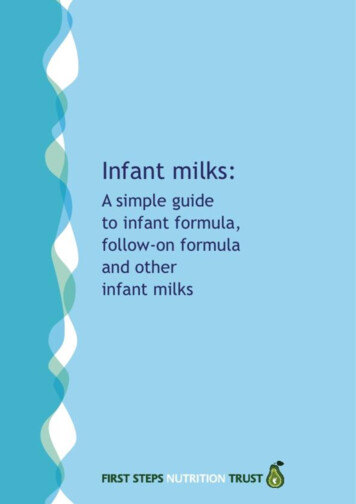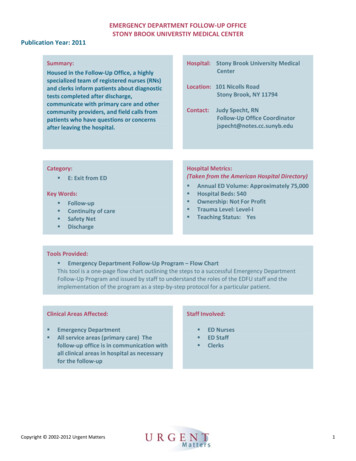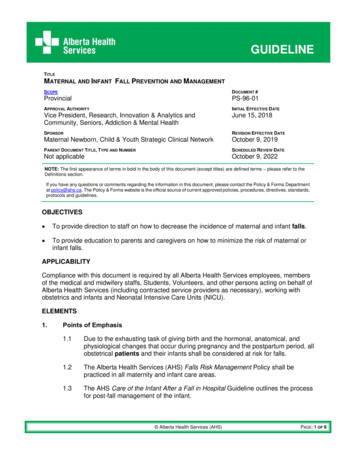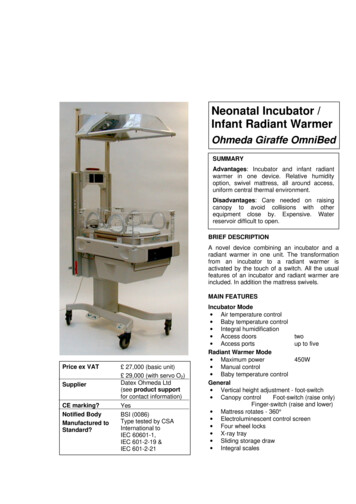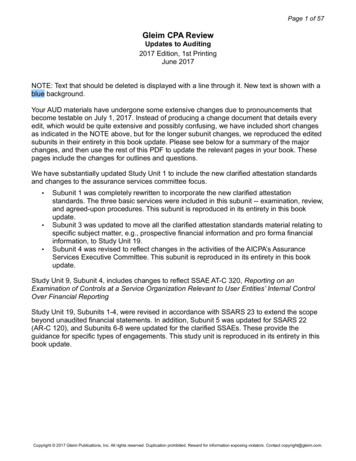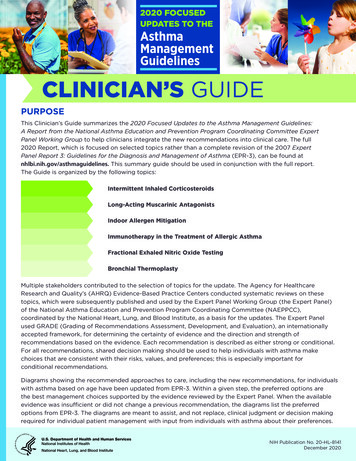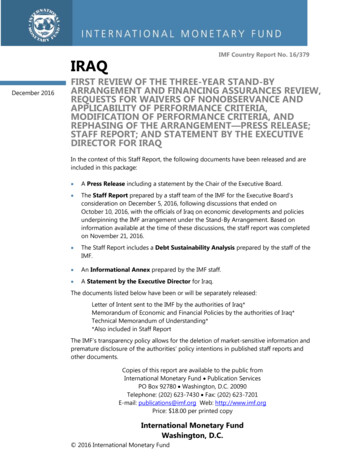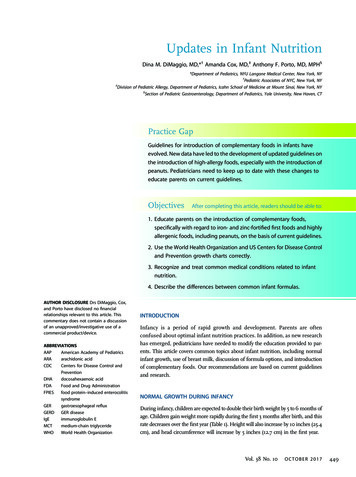
Transcription
Updates in Infant NutritionDina M. DiMaggio, MD,*† Amanda Cox, MD,‡ Anthony F. Porto, MD, MPH§*Department of Pediatrics, NYU Langone Medical Center, New York, NY†Pediatric Associates of NYC, New York, NY‡Division of Pediatric Allergy, Department of Pediatrics, Icahn School of Medicine at Mount Sinai, New York, NY§Section of Pediatric Gastroenterology, Department of Pediatrics, Yale University, New Haven, CTPractice GapGuidelines for introduction of complementary foods in infants haveevolved. New data have led to the development of updated guidelines onthe introduction of high-allergy foods, especially with the introduction ofpeanuts. Pediatricians need to keep up to date with these changes toeducate parents on current guidelines.ObjectivesAfter completing this article, readers should be able to:1. Educate parents on the introduction of complementary foods,specifically with regard to iron- and zinc-fortified first foods and highlyallergenic foods, including peanuts, on the basis of current guidelines.2. Use the World Health Organization and US Centers for Disease Controland Prevention growth charts correctly.3. Recognize and treat common medical conditions related to infantnutrition.4. Describe the differences between common infant formulas.AUTHOR DISCLOSURE Drs DiMaggio, Cox,and Porto have disclosed no financialrelationships relevant to this article. Thiscommentary does not contain a discussionof an unapproved/investigative use of acommercial product/device.ABBREVIATIONSAAPAmerican Academy of PediatricsARAarachidonic acidCDCCenters for Disease Control andPreventionDHAdocosahexaenoic acidFDAFood and Drug AdministrationFPIESfood protein–induced enterocolitissyndromeGERgastroesophageal refluxGERDGER diseaseIgEimmunoglobulin EMCTmedium-chain triglycerideWHOWorld Health OrganizationINTRODUCTIONInfancy is a period of rapid growth and development. Parents are oftenconfused about optimal infant nutrition practices. In addition, as new researchhas emerged, pediatricians have needed to modify the education provided to parents. This article covers common topics about infant nutrition, including normalinfant growth, use of breast milk, discussion of formula options, and introductionof complementary foods. Our recommendations are based on current guidelinesand research.NORMAL GROWTH DURING INFANCYDuring infancy, children are expected to double their birth weight by 5 to 6 months ofage. Children gain weight more rapidly during the first 3 months after birth, and thisrate decreases over the first year (Table 1). Height will also increase by 10 inches (25.4cm), and head circumference will increase by 5 inches (12.7 cm) in the first year.Vol. 38 No. 10OCTOBER 2017449
TABLE 1.Normal Infant Weight GainAGEMEAN WEIGHT GAIN0–3 mo1 oz or approximately 30 g/d3–6 mo1 oz every other d or approximately 15 g/d6–12 mo1 oz every 3 d or approximately 10 g/dA good resource for identifying patterns of excessive weightloss in the first few days to 1 month after birth is the NewbornWeight Tool, or NEWT. It is a nomogram from a KaiserPermanente database (www.newbornweight.org) that is basedon weight patterns in a cohort of more than 100,000 breastfednewborns and more than 7,000 exclusively formula-fed infantswho were born at at least 36 weeks of gestational age.USE OF GROWTH CHARTSThe US Centers for Disease Control and Prevention (CDC)and the World Health Organization (WHO) publish the 2most commonly used reference growth charts for infantsand toddlers. However, currently, the CDC recommends theuse of the WHO growth charts for children 0 to 24 monthsof age, while CDC growth charts should still be used forchildren 2 years of age and older. WHO growth charts,which were established in 2006, are a better representationof how children should grow in the United States today, ascompared to CDC growth charts. (1) Results of a survey of USinfants in 2009 showed that 77% of infants were breastfed atleast once, 47% were breastfed for at least 6 months, and 26%were breastfed at 12 months. (2) The WHO charts provide abetter estimation of growth for children who are breastfed andalso include a larger and more diverse sample size (Table 2).Formula-fed infants gain weight more rapidly in the first 3months after birth, while breastfed infants grow more slowlyduring the first year. As a result, when a breastfed infant’sgrowth is plotted on a CDC growth chart, it may seem as if theinfant is not gaining weight adequately. For this reason, it isrecommended that pediatricians always check which growthchart is being used, particularly when using electronic medicalrecord systems in which both forms may be incorporated.FREQUENCY AND AMOUNT PER FEEDINGParents are often concerned about whether a newborn isfeeding an appropriate number of times per day andwhether the newborn is ingesting an adequate quantityat each feeding. The amount a baby will consume willvary for each newborn and between different feedings450Pediatrics in Reviewthroughout the day for the same newborn. On average, afull-term newborn will breastfeed on demand approximatelyevery 2 to 3 hours, or 8 to 12 times per day, while formula-fedbabies will consume 2 oz every 3 to 4 hours. These feedingsshould result in an intake of 140 to 200 mL per kilogram ofbody weight per day, providing 90 to 135 kcal/kg per day forthe first 3 months and the expected weight gain of 25 to 30 gper day. (3) By 8 to 12 months, babies will tend to breastfeed 3to 4 times per day and drink approximately 7 to 8 oz perbottle. Table 3 summarizes an approximate feeding schedulefor the first year; however, it is best to respond to an infant’sfeeding cues and hydration status rather than feed fixedamounts or adhere to a rigid schedule.Over 12 months, an infant may breastfeed as often as thebaby and mom desire, from 1 or 2 times to multiple timesper day. If there is no allergy to cow milk, infants who areformula fed may begin drinking whole milk at 1 year of age at amaximum amount of 16 to 24 oz a day. Intake of milk abovethis recommended amount is associated with increased risk ofiron deficiency and subsequent anemia. The American Academy of Pediatrics (AAP) recommends introducing reduced-fatmilk between 12 months and 2 years of age in children at risk ofbeing overweight or for those whose families have a history ofobesity, heart disease, or high cholesterol.BREASTFEEDINGThe AAP recommends exclusive breastfeeding for approximately 6 months, after which complementary foods areintroduced, along with breastfeeding until 1 year of age orlater, as long as desired by mother and infant. The benefitsof breastfeeding are well documented for both infant andmother and are listed in Table 4. It is not clear, however,TABLE 2.Differences between WHO (0–24months) and CDC (0–36 months)Growth ChartsCDCWHOApproximately 50% of infantswere breastfed at least once33% of infants still breastfed at3 mo100% of infants predominantlybreastfed for at least 4 mo andat least partially breastfed for12 moUS data onlyData from India, California,Ghana, Oman, and NorwayNo longitudinal data(4,697 observations)Longitudinal data (18,973observations in 882 children)CDC¼Centers for Disease Control and Prevention, WHO¼World HealthOrganization.
TABLE 3.Approximate Feeding Schedule for the First Year after BirthAGEFORMULA FEDBREASTFEDFull-term newborn2 oz every 3–4 hOn demand every 2–3 h or 8–12 times per d1 mo3–4 oz every 3–4 hOn demand every 2–4 h or 7–8 times per d2–4 mo3–6 oz 5–8 times per dOn demand 5–8 times per d4–6 mo4–6 oz 4–6 times per d4–6 times per d6–8 mo6–8 oz 3–5 times per d3–5 times per d8–12 mo7–8 oz 3–4 times per d3–4 times per d1 y and older16–24 oz whole milk per d1–2 times to multiple times per d, as long asmom and baby desireAccording to reference 4.whether exclusive breastfeeding has an effect on the development of allergic rhinitis, food allergies, later childhoodasthma, or eczema after the age of 2 years.CONTRAINDICATIONS TO BREASTFEEDINGMedical contraindications to breastfeeding are few. Infantswith a diagnosis of galactosemia cannot breastfeed, theyrequire lactose-free milk, and they are most often started ona soy-based formula. Maternal infection with human T-celllymphotropic virus type I or II, untreated brucellosis, and, inthe United States, HIV, are also contraindications to breastfeeding; in these cases, mothers should neither breastfeednor provide expressed breast milk to their infants. In motherswith untreated active tuberculosis, expressed breast milk maybe provided, and breastfeeding may later begin once a motherreceives treatment with antituberculosis drugs for approximately 2 weeks and is proven to no longer be infectious.Mothers with the onset of varicella 5 days before a newborn’sbirth through 2 days after the birth will be separated from theirnewborn, but they may provide expressed breast milk; likewise,mothers with H1N1 influenza should be separated from theirneonates until they are afebrile, but they can provide expressedmilk. Mothers with active herpes simplex lesions on the breastmay also provide expressed breast milk.Although most prescribed medications are compatiblewith breastfeeding, there are a few classes of drugs, including amphetamines, chemotherapy agents, ergotamines, andstatins, for which risks associated with breastfeeding havebeen identified. When uncertain about compatibility, healthcare providers may use LactMed (online at https://toxnet.nlm.nih.gov/newtoxnet/lactmed.htm), a resource publishedby the National Library of Medicine and the National Institutesof Health, for further recommendations.Maternal substance abuse may not be a contraindicationto breastfeeding in all cases; a thorough evaluation shouldbe performed prior to breastfeeding. For instance, HIVnegative mothers who are taking narcotics may breastfeed ifthey are in a methadone maintenance program; however,breastfeeding is contraindicated in mothers taking phencyclidine, cocaine, and cannabis. Mothers who wish to drinkalcohol should drink no more than 0.5 g of alcohol perkilogram of body weight; alcohol consumption should occursoon after nursing the infant to ensure that there is a maximaltime until the next feeding—ideally more than 2 hours—toreduce the alcohol concentration in the breast milk.BREAST MILK STORAGEIt is recommended that breast milk be stored in 2- to 4-ozaliquots to prevent any waste. If a baby drinks from a bottleof breast milk, any remaining breast milk should be consumed within 2 hours, or if it is refrigerated right after afeeding, it may be used for the next feeding. Breast milk canbe left at room temperature (up to 77 F or 25 C) for 4 hours,or if very cleanly expressed, up to a maximum of 6 to 8hours. When refrigerating breast milk, it should be placed inthe back of the refrigerator (39 F or 4 C) so it is not exposedto temperature variations with the opening and closing ofthe refrigerator door and should be consumed within 4 daysor up to a maximum of 8 days. If freshly expressed breastmilk will not be used within 24 hours, then it should befrozen and stored in the back of a freezer. If the milk isfrozen in a refrigerator with a separate freezer door (0 F or 18 C), breast milk may be stored for up to 9 months. Iffrozen in a chest or deep freezer ( 4 F or 20 C), it can bestored for 12 months. After breast milk is thawed, it shouldbe refrigerated and consumed within 24 hours (Table 5).Vol. 38 No. 10OCTOBER 2017451
TABLE 4.Breastfeeding Benefits for Infant and MotherBENEFITS TO THE INFANT Breastfeeding provides complete nutrition. Breastfeeding reduces the incidence of upper respiratory tract infections,nonspecific gastrointestinal tract infections, otitis media, respiratorysyncytial virus bronchiolitis, asthma, obesity, necrotizing enterocolitis,sudden infant death syndrome, inflammatory bowel disease, leukemia,and type 1 diabetes. Breastfed babies have been linked to having higher intelligence scores.MATERNAL BENEFITSShort-term effects include the following: A decrease in postpartum bleeding More rapid involution of the uterus A possible decreased risk of postpartum depressionPotential long-term effects include the following: Decreased risk of type 2 diabetes mellitus in motherswithout a history of gestational diabetes Lower risk for rheumatoid arthritis Decreased incidence of hypertension, hyperlipidemia,and cardiovascular disease Reduction in breast and ovarian cancer May help mothers return to their prepregnancy weight Promotes maternal-infant bonding Saves moneyAccording to reference 5.VITAMIN D SUPPLEMENTATIONCases of rickets secondary to vitamin D deficiency, due toinadequate intake or decreased sunlight exposure, continueto occur in the United States. Maternal vitamin D statusaffects the vitamin D content of breast milk and thereforecan vary, creating concern over whether breast milk providesinfants with adequate vitamin D levels. Although breastfedinfants of mothers supplemented with 6,400 IU per dayof vitamin D have 25-hydroxyvitamin D levels comparableto those in infants receiving 300 to 400 IU of vitamin Dper day, more studies are needed before universal supplementation of mothers with high-dose vitamin D is recommended. (6) Current recommendations state that allexclusively breastfed babies should be supplemented with400 IU of vitamin D per day, starting a few days after birth.Babies should continue taking vitamin D unless weaned to32 oz of vitamin D–fortified formula (approximately 1 L) orvitamin D–fortified whole milk, which the infant can betransitioned to at 1 year of age. Likewise, if exclusivelyformula-fed babies are consuming less than 32 oz of formula per day, or if older children are drinking less than 1 Lof whole milk per day, they may also need a vitamin Dsupplement of 400 IU per day, depending on their intake ofother dietary sources of vitamin D. (7)DONOR MILKGiven the benefits of breast milk, both the AAP and theEuropean Society for Pediatric Gastroenterology, Hepatology,and Nutrition recommend that premature infants be fedbreast milk from their own mother and that breast milk befortified with either human milk fortifier or infant formula452Pediatrics in Reviewfor infants who weigh less than 1.5 kg. (8)(9) Pasteurizeddonor milk is an acceptable alternative for infants who areunable to receive breast milk from their biological mothersor for temporary feeding of newborns with very low birthweight whose mothers are not yet producing sufficientbreast milk. Although it is believed that some componentsof breast milk, including neutrophils, stem cells, and immunoglobulins, may be reduced by the pasteurization process,donor milk must be pasteurized. It is not recommended,however, that donor milk be obtained from the Internetor directly from an individual. Milk obtained from thesesources may not have been safely handled or tested properlyfor bacteria, viruses (such as HIV, cytomegalovirus, hepatitis), or other sources of contamination. (10) Establishedhuman milk banks have standards for screening milkdonors and take steps to safely collect, process, test, andstore donor milk. Of note, the Food and Drug Administration(FDA) does not oversee or set these standards. The HumanMilk Banking Association of North America (or HMBANA,a voluntary professional association for nonprofit donorhuman milk banks; www.hmbana.org) has guidelines thatare used by many states to guide the operation of facilitiesand distribution of donor milk within the state. In somestates, insurance companies may cover the cost of humandonor milk, especially if it is being used for premature orother high-risk infants; however, reimbursement is inconsistent between states. (11)FORMULAThere are a variety of formulas available (Table 6), and newones are continually being added. The FDA sets guidelinesso that all infant formulas contain a set of standard nutrients
TABLE 5.Breast Milk Storage GuidelinesENVIRONMENTTIMERoom temperature4 h, with a maximum of 6–8 h ifvery cleanly expressedRefrigeratorUp to 4 d, up to 8 d if very cleanlyexpressedFreezer (in a refrigerator witha separate freezer door)Up to 9 moDeep freezerUp to 12 mounder its own federal law, “the infant formula act.” Everyinfant formula manufacturer is required to test each formulaand then submit these results to the FDA to ensure that eachformula meets FDA standards. Like breast milk, which contains 18 to 20 calories per ounce, nearly all formulas contain 19to 20 calories per ounce when mixed as instructed. All formulasare also designed to provide sufficient amounts of vitamins andmicronutrients, including iron, linoleic acid, and vitamins Cand E. Although formula contains vitamin D, as stated earlier,an infant must drink at least 32 oz of formula per day to meetthe daily requirements for this nutrient.The major differences among formulas include theamount of protein, sugar, and fat sources they contain. Mostchildren will do well on a cow milk protein–based formula.These formulas typically contain lactose as the sugar sourceand a modified cow milk protein that is easier for an infant todigest. These formulas consist of approximately 80% caseinand 20% whey protein, while breast milk contains approximately 70% whey and 30% casein. Partially hydrolyzed proteinformulas and low-lactose or lactose-free formulas containmore whey than casein protein to mimic the components ofbreast milk. Some children, particularly those with allergicproctocolitis, or an allergy to cow milk, will require extensivelyhydrolyzed protein formula or amino acid–based formulas.These formulas are lactose free, contain glucose (primarily inthe form of corn syrup solids), and contain proteins that havebeen broken down into smaller peptides or amino acids toprevent an allergic response. Partially hydrolyzed formulas maycontain larger-sized proteins and are not effective in thetreatment of allergic proctocolitis. Soy protein formulas arealso lactose free and contain corn syrup solids as their carbohydrate source, contain soy protein, are used in certain metabolicconditions (including galactosemia) and are used by familieswho are seeking a vegetarian-based diet for term infants.Fat sources among formulas may vary, but an importantfactor is the percentage of medium-chain triglycerides(MCTs) and long-chain triglycerides. MCTs are easily absorbed fats that can be helpful in ensuring adequate growthin children with liver disease and short bowel syndrome, asthese fats can be absorbed directly in the intestines withoutbile salts or micelle formation. In general, MCTs make up atleast 33% of total fat in most complete protein hydrolysateand amino acid–based formulas.In addition, over the past 20 years, additional ingredientshave been added to some infant formulas. For example,omega-3 fatty acids, including docosahexaenoic acid (DHA)and arachidonic acid (ARA), have been added to most formulas, as they are found naturally in breast milk. Children whoare breastfed have higher blood levels of both ARA and DHA,and both, especially DHA, have been associated with eye andbrain development in infants. Data on the DHA and ARA informula are mixed. (12) Other ingredients that have been addedto formula to mimic breast milk include lactoferrin, milk fatglobule membrane, and prebiotics, including gluco- or fructooligosaccharides. Probiotics have also been added to formulas.The benefits of these additives are still under investigation.Finally, organic formulas and formulas with non–geneticallymodified organisms have become commercially available.Premature NewbornsPremature newborns may drink breast milk, although theytypically need supplementation to ensure adequate amountsof calories, minerals, and vitamins. Breast milk may befortified with human milk fortifier or infant formula to meetthe nutritional needs of premature newborns. Prematureinfant formulas contain higher levels of protein, sodium,potassium, phosphorus, and calcium. These formulas alsocontain more calories per ounce and may need to be continueduntil adequate growth and weight gain are obtained.In addition, pr
Updates in Infant Nutrition Dina M. DiMaggio, MD,*† Amanda Cox, MD,‡ Anthony F. Porto, MD, MPH§ *Department of Pediatrics, NYU Langone Medical Center, New York, NY †Pediatric Associates of NYC, New York, NY ‡Division of Pediatric Allergy, Department of Pediatrics, Icahn School of Medicine at Mount Sinai, New York, NY §Section of Pediatric Gastro
